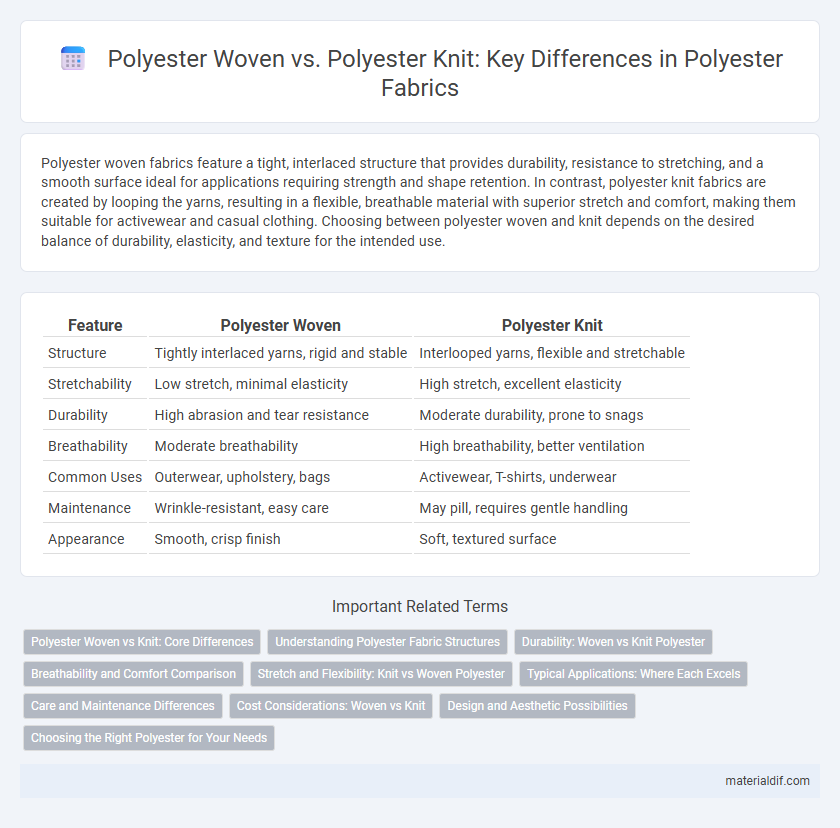Polyester woven fabrics feature a tight, interlaced structure that provides durability, resistance to stretching, and a smooth surface ideal for applications requiring strength and shape retention. In contrast, polyester knit fabrics are created by looping the yarns, resulting in a flexible, breathable material with superior stretch and comfort, making them suitable for activewear and casual clothing. Choosing between polyester woven and knit depends on the desired balance of durability, elasticity, and texture for the intended use.
Table of Comparison
| Feature | Polyester Woven | Polyester Knit |
|---|---|---|
| Structure | Tightly interlaced yarns, rigid and stable | Interlooped yarns, flexible and stretchable |
| Stretchability | Low stretch, minimal elasticity | High stretch, excellent elasticity |
| Durability | High abrasion and tear resistance | Moderate durability, prone to snags |
| Breathability | Moderate breathability | High breathability, better ventilation |
| Common Uses | Outerwear, upholstery, bags | Activewear, T-shirts, underwear |
| Maintenance | Wrinkle-resistant, easy care | May pill, requires gentle handling |
| Appearance | Smooth, crisp finish | Soft, textured surface |
Polyester Woven vs Knit: Core Differences
Polyester woven fabric features a tight, crisscross pattern of interlaced yarns, offering durability, wrinkle resistance, and a structured texture ideal for formal wear and upholstery. In contrast, polyester knit fabric is created by looping yarns together, providing stretchability, softness, and breathability, commonly used in activewear and casual clothing. The core differences lie in the weaving technique, elasticity, and fabric hand feel, influencing their respective applications and performance characteristics.
Understanding Polyester Fabric Structures
Polyester woven fabric consists of interlaced yarns arranged in a perpendicular pattern, providing durability and a crisp texture ideal for formal wear and upholstery. Polyester knit fabric features interconnected loops of yarn, offering greater stretch, breathability, and comfort, making it suitable for activewear and casual clothing. Understanding these structural differences helps in selecting the appropriate polyester fabric based on desired flexibility, appearance, and end-use performance.
Durability: Woven vs Knit Polyester
Polyester woven fabric offers superior durability due to its tightly interlaced fibers, providing enhanced resistance to abrasion and tearing compared to polyester knit. Knit polyester, characterized by its looped construction, delivers greater stretch and flexibility but tends to be more susceptible to pilling and snagging over time. For applications requiring robust wear and longevity, woven polyester is the preferred choice, especially in industrial or heavy-duty textiles.
Breathability and Comfort Comparison
Polyester woven fabrics offer a tighter structure that provides durability and water resistance but generally lower breathability compared to polyester knit fabrics, which feature a looped knit construction allowing for enhanced airflow and moisture wicking. Polyester knits excel in comfort due to their stretchability and softness, making them ideal for activewear and casual clothing, while woven polyester is preferred for structured garments like jackets and pants. The choice between polyester woven and knit fabrics significantly impacts the overall breathability and comfort level based on the intended use and environmental conditions.
Stretch and Flexibility: Knit vs Woven Polyester
Polyester knit fabric offers superior stretch and flexibility compared to woven polyester due to its looped yarn structure, allowing greater elasticity and comfort in activewear and casual clothing. Woven polyester, characterized by interlaced yarns in a fixed pattern, provides limited stretch primarily along the bias, resulting in a more rigid and durable fabric ideal for structured garments. Understanding these differences is crucial for selecting the appropriate polyester type based on the required flexibility and movement in the final product.
Typical Applications: Where Each Excels
Polyester woven fabrics excel in applications requiring durability and structure, such as outdoor gear, upholstery, and formal wear due to their tight weave and resistance to abrasion. Polyester knit fabrics are preferred for activewear, casual clothing, and stretchable garments because of their flexibility, breathability, and moisture-wicking properties. The distinct construction methods of woven and knit polyester dictate their suitability for either rigid, long-lasting items or comfortable, stretchy apparel.
Care and Maintenance Differences
Polyester woven fabrics require gentle washing in cold water with mild detergents to prevent shrinkage and maintain fabric integrity, while polyester knits are more stretchable and can withstand machine washing on gentle cycles without losing shape. Avoiding high heat in drying is crucial for woven polyester to prevent stiffness, whereas knit polyester benefits from air drying to preserve elasticity. Regular ironing at low temperatures is recommended for woven polyester, while knit polyester typically resists wrinkles and needs minimal ironing.
Cost Considerations: Woven vs Knit
Polyester woven fabrics generally incur higher production costs due to their complex weaving process and greater material usage compared to polyester knit fabrics, which are produced through a more efficient looping technique. Knit polyester typically offers better cost efficiency, making it suitable for budget-conscious projects requiring stretch and comfort. The price difference between woven and knit polyester reflects their distinct manufacturing processes and end-use applications, influencing overall budget decisions in textile selection.
Design and Aesthetic Possibilities
Polyester woven fabrics offer a smooth, structured surface ideal for sharp, tailored designs and intricate patterns, lending a polished, professional aesthetic. Polyester knit fabrics provide exceptional stretch and flexibility, enabling dynamic, form-fitting garments with a more casual, textured appearance. These distinct construction methods expand design possibilities by balancing durability and comfort to suit diverse fashion applications.
Choosing the Right Polyester for Your Needs
Polyester woven fabrics offer durability, resistance to wrinkles, and a crisp appearance, making them ideal for formal wear and upholstery. Polyester knit fabrics provide superior stretch, breathability, and comfort, suitable for activewear and casual clothing. Selecting the right polyester depends on the desired texture, flexibility, and end-use requirements of the garment or product.
Polyester woven vs Polyester knit Infographic

 materialdif.com
materialdif.com